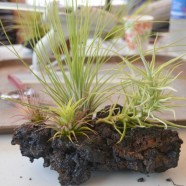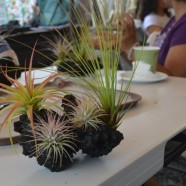Tillandsia’s by Sharon
What are Air Plants?
Tillandsia is part of the Bromeliad family, the Genus name is Tillandsia which is also the common name, these are further broken down into species name, most people just call them Air plants. There are over 550 species of Tillandsia (plus many hybrids), that grow in the Mexico, South and Central Americas. They grow naturally only in the New World, with the exception of only one species. There are only 16 species that are native of Florida.
Tillandsias take all their water and nutrients through the leaf system, none or very minimal amounts are absorbed by the root system. This root system is used as wire like anchors to hold onto trees, rocks etc. Since the root system is not important to the plant this can be removed without harm, to make your plant easier to mount. The roots may or may not grow back, either way is doesn’t matter to the welfare of your plant.
Growth Cycle
Bromeliad Tillandsia has a life cycle of one plant growing to maturity and blooming. Before, during or after blooming (depending on the species) your plant will start producing young (PUPS), most plants will produce between 2 – 8 pups which in turn will mature, generally within a year and in turn bloom and produce pups. So this year you have one plant, next year maybe 6, the next year 36 and so on. Your plant will actually look better next year than this year as it starts to clump and produce more blooms. The bad news is that each plant will only flower once in its lifetime, but you should have blooms each year as the pups mature, and in turn flower. Flowers can last from several days to many months, depending on the species, most Tillandsia bloom naturally in late winter through mid-summer.
General Info
Tillandsias DO have to be watered; they live ‘in’ air, not ‘on’ air.
Tillandsias are NOT toxic to animals, although this does not mean your pet won’t eat them, but they will survive the experience, your plant might not.
Tillandsias are NOT parasitic; they do not harm the host tree.
Trim away brown, bent or damaged leaves, this will not hurt the plant.
Air Plants Care
Watering
One of the most common things we hear people say is “I had one of these plants once but it died “, the first thing we ask is “How were you watering it?”
Watering is one of the most important aspects of succeeding with Tillandsias, and one of the most misunderstood. Because their common name is Air Plants people tend to think of these plants as needing little or no water (as living on air). This is the biggest mistake you can make. Tillandsias NEED water, although they can survive for long periods of drought, they are NOT GROWING and certainly not thriving in these conditions, they are going dormant and just trying to survive, and will eventually die if water is scarce for too long, though it’s amazing how long they’ll “hang in there” with very little water.
Now having said that, your plant will also rot and die if left wet for too long…………..
Basically this means your plant wants water, but needs to dry out completely before being watered again. Plants should be given enough light and air circulation to dry in no longer than 4 hours after watering. It’s best to water your plants in the morning so they dry by nightfall.
Humidity is NOT a source of water for your plant. Tillandsias can only obtain their water if it is sat on their leaves, in nature through dew, fog and rain. Humidity only delays the drying process. Tillandsias are covered in suction scales (trichomes) which capture moisture; these scales automatically close when your plant has enough moisture. Get to know your plant, handle the leaves, after watering the leaves will feel stiff and full of water, when in need of water they will be softer to the touch and the plant will be lighter in color. Dehydration can be noticed by flaccid, wrinkled or rolled leaves.
Watering Schedule
Your plant needs to be watered regularly, at least 2 to 3 times per week. Misting is generally not sufficient even if done daily; they need to be watered (underneath as well as on top) to the point of runoff as though they’ve just gone through a rain storm, AT LEAST twice a week. The easiest way to achieve this is to actually immerse the whole plant in the sink or buckets if possible, if not, use a hose or the kitchen faucet to totally wet your plant. Your plant will also appreciate a good soaking for several hours every one to two weeks (although never submerge the blooming flower for more than a few seconds, or the petals will dissolve, of course if you’re going away for several weeks it is more important to give your plant sufficient water, than to the preserving of the bloom). In extremely dry conditions, or in the house or office with air conditioning or heating going, your plant may require more water, if your plant looks dry (check in the leaf sheaths, and the base of the plant) you could water daily if required, as long as the plant dries out before being watered again, you will not cause harm to the plant (there are exceptions to this rule, if you’ve purchased a different care plant you should have been informed). Shake out any excess water from your plant container; don’t forget your plant wants to dry out by nightfall, not to be left sat in water. Shake off any excess water from fleshy plants. Give thin leaf varieties an extra spray on their tips as they dry out faster.
Vacationing
If you are going for several months place your plant outside where your sprinkler system will water it for you, light shade area. Or if you are going on a short vacation (under one month). Soak your plant for 4 hours 3 days before you go then soak again for 12 hours immediately before you leave, place the plant in a shady (not dark) spot and go ENJOY your vacation. Upon returning your plant will show a little leaf damage and will look dehydrated, immediately soak for 12 hours and for another 4 hours 2 or 3 days later, then resume normal watering, your plant should start to revive several hours after immersion. Your plant just went dormant while you were on vacation, given good water and light it will wake up again.
Lighting
Adequate light is the second most important factor in growing a strong healthy plant, water being the first.
Give your plant as bright a light as you can, without causing burning. Indoors we recommend no further than 10 feet from a window or skylight. Outdoors under a tree, carport, patio or shade cloth would be ideal. Partial sun for an hour or so in the morning or evening should be okay, but you should avoid all day direct sun.
Be careful of placing directly in south facing windows as the amplified heat may cause excessive drying of the plant and burning (good air circulation i.e. the window open to conduct the heat away from the plant should stop this problem).
In Offices fluorescent lighting will normally provides the proper color range for good plant growth, this can always be supplemented with a desk lamp if necessary.
If your plant loses its color after blooming, this is natural; all its energy is now going into producing pups. If your plant (especially ionanthas) loses its color before blooming it’s not getting sufficient light, move to a lighter location.
Having said all that remember full sun and partial sun are very different in summer and winter, and the intensity is very different in Manoa to Ewa.
Fertilizing
Fertilizing Tillandsia is not really necessary, but it will result in faster growth, better flowers and more pups. When fertilizing your plant be very careful not to overdo it, Tillandsias are very susceptible to over fertilization. Over fertilizing or using the wrong kind of fertilizer is a very good way to kill your plant.
Use a good WATER SOLUBLE fertilizer at 1/4 the strength recommended on the label, and use it only once a month.
Enjoy your Tillandsia, Aloha, Sharon






